Education and Sustainable Future: A Comprehensive Analysis
VerifiedAdded on 2022/10/10
|16
|4085
|17
Essay
AI Summary
This essay delves into the critical relationship between education and a sustainable future, emphasizing the need for curriculum development that fosters environmental awareness and responsible citizenship. It examines a case study of a primary school, XYZ International, highlighting its efforts to integrate sustainability into its curriculum through recycling programs, promoting clean energy sources, and encouraging critical thinking. The essay explores the concept of eco-literacy, discussing its benefits and limitations, and stresses the importance of instilling values of citizenship and environmental responsibility in students. The essay also analyzes how education can address global complexities, shifting perspectives, and ultimately contribute to the creation of a sustainable future. The importance of early childhood education is emphasized, referencing the Early Years Learning Framework and its role in shaping young children's understanding of the world. The essay concludes by underscoring education's pivotal role in empowering future generations to create a more sustainable world.
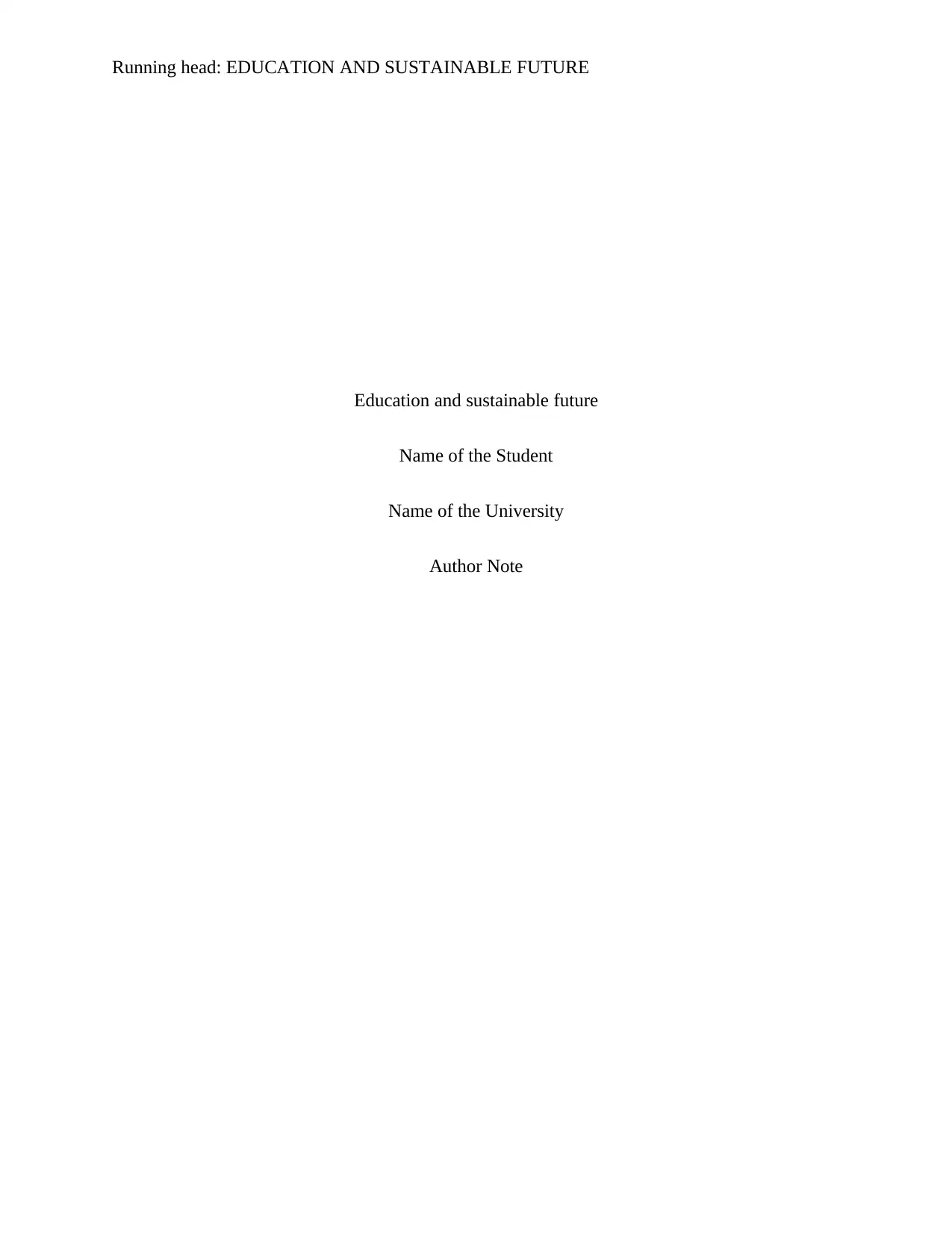
Running head: EDUCATION AND SUSTAINABLE FUTURE
Education and sustainable future
Name of the Student
Name of the University
Author Note
Education and sustainable future
Name of the Student
Name of the University
Author Note
Paraphrase This Document
Need a fresh take? Get an instant paraphrase of this document with our AI Paraphraser
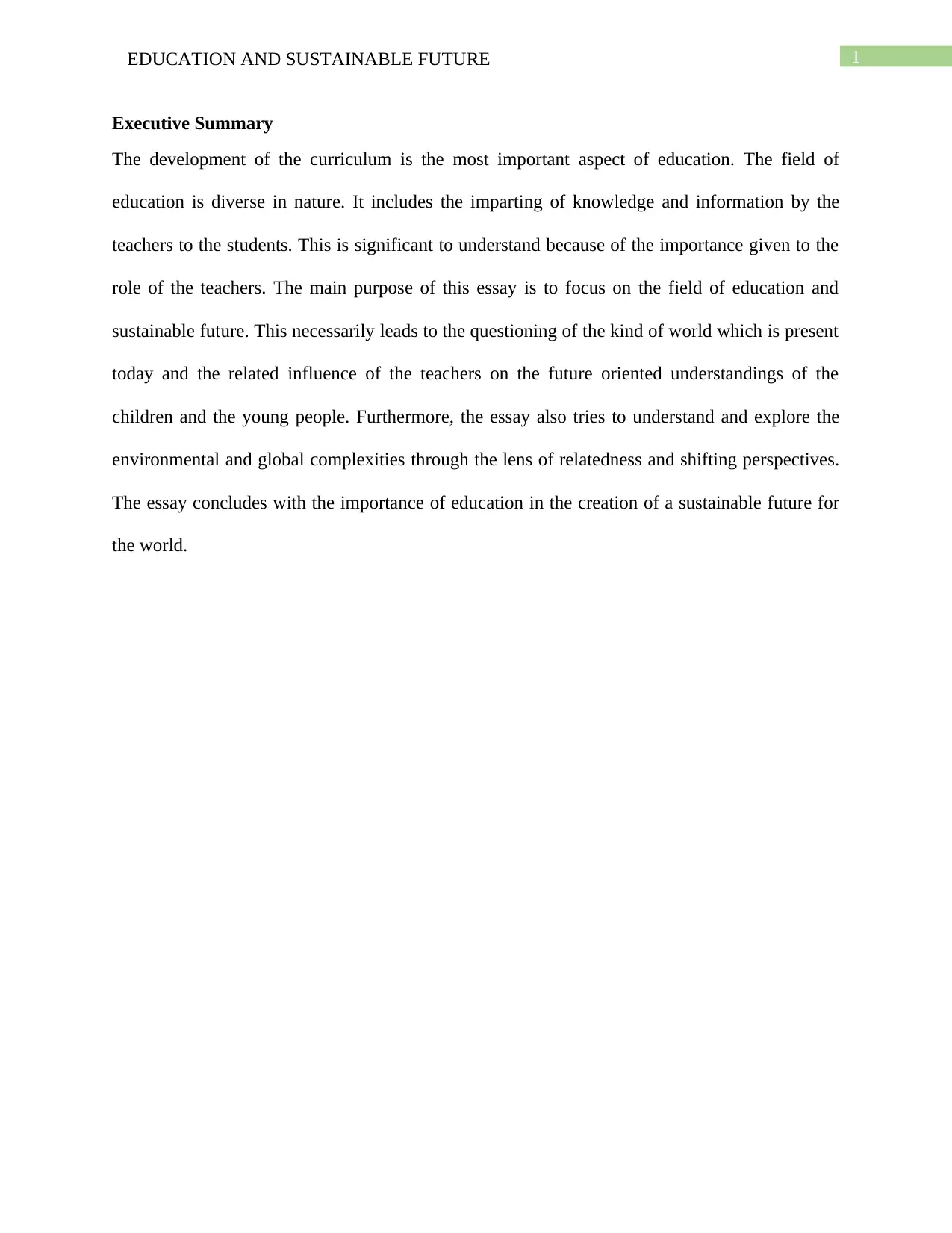
1EDUCATION AND SUSTAINABLE FUTURE
Executive Summary
The development of the curriculum is the most important aspect of education. The field of
education is diverse in nature. It includes the imparting of knowledge and information by the
teachers to the students. This is significant to understand because of the importance given to the
role of the teachers. The main purpose of this essay is to focus on the field of education and
sustainable future. This necessarily leads to the questioning of the kind of world which is present
today and the related influence of the teachers on the future oriented understandings of the
children and the young people. Furthermore, the essay also tries to understand and explore the
environmental and global complexities through the lens of relatedness and shifting perspectives.
The essay concludes with the importance of education in the creation of a sustainable future for
the world.
Executive Summary
The development of the curriculum is the most important aspect of education. The field of
education is diverse in nature. It includes the imparting of knowledge and information by the
teachers to the students. This is significant to understand because of the importance given to the
role of the teachers. The main purpose of this essay is to focus on the field of education and
sustainable future. This necessarily leads to the questioning of the kind of world which is present
today and the related influence of the teachers on the future oriented understandings of the
children and the young people. Furthermore, the essay also tries to understand and explore the
environmental and global complexities through the lens of relatedness and shifting perspectives.
The essay concludes with the importance of education in the creation of a sustainable future for
the world.
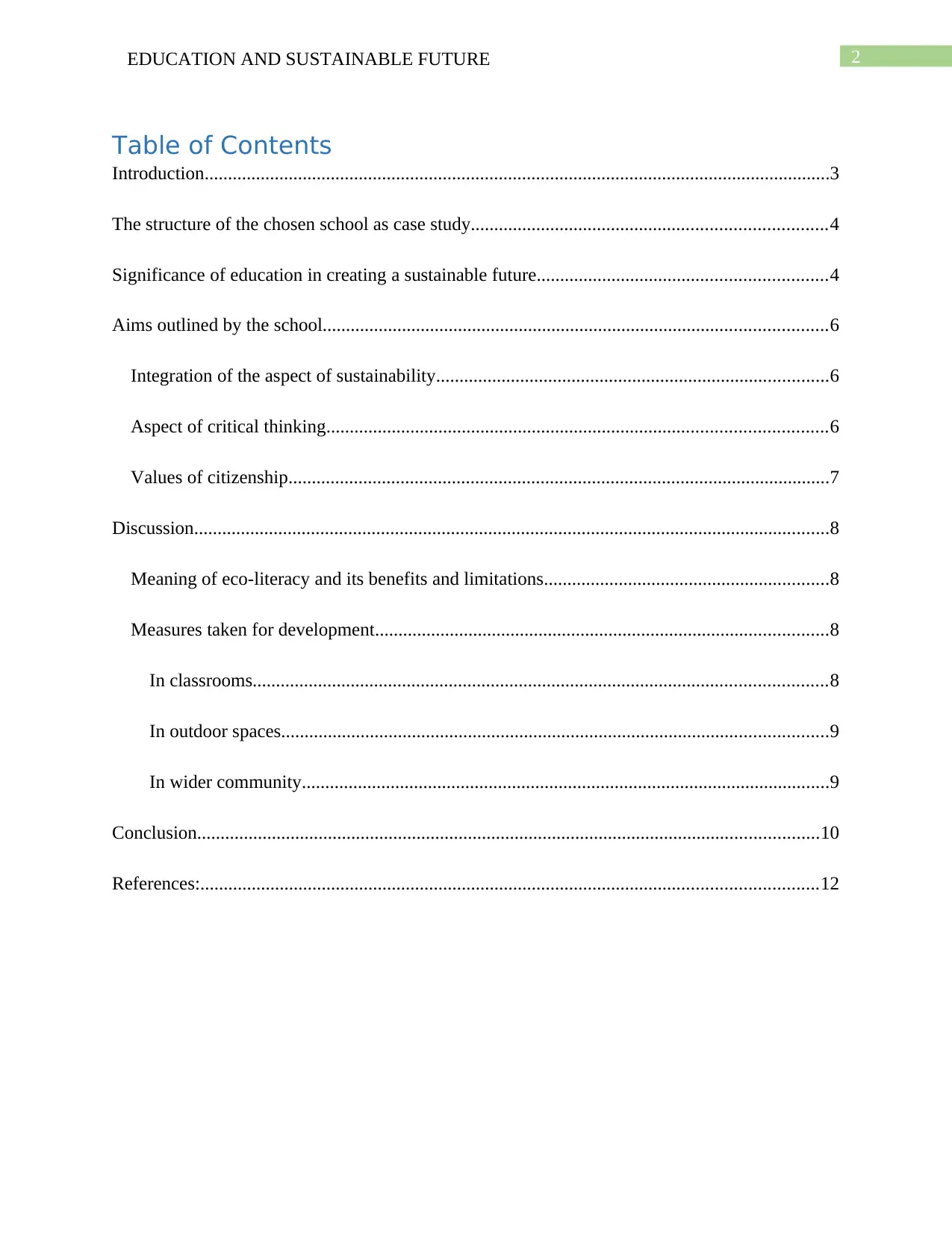
2EDUCATION AND SUSTAINABLE FUTURE
Table of Contents
Introduction......................................................................................................................................3
The structure of the chosen school as case study............................................................................4
Significance of education in creating a sustainable future..............................................................4
Aims outlined by the school............................................................................................................6
Integration of the aspect of sustainability....................................................................................6
Aspect of critical thinking...........................................................................................................6
Values of citizenship....................................................................................................................7
Discussion........................................................................................................................................8
Meaning of eco-literacy and its benefits and limitations.............................................................8
Measures taken for development.................................................................................................8
In classrooms...........................................................................................................................8
In outdoor spaces.....................................................................................................................9
In wider community.................................................................................................................9
Conclusion.....................................................................................................................................10
References:....................................................................................................................................12
Table of Contents
Introduction......................................................................................................................................3
The structure of the chosen school as case study............................................................................4
Significance of education in creating a sustainable future..............................................................4
Aims outlined by the school............................................................................................................6
Integration of the aspect of sustainability....................................................................................6
Aspect of critical thinking...........................................................................................................6
Values of citizenship....................................................................................................................7
Discussion........................................................................................................................................8
Meaning of eco-literacy and its benefits and limitations.............................................................8
Measures taken for development.................................................................................................8
In classrooms...........................................................................................................................8
In outdoor spaces.....................................................................................................................9
In wider community.................................................................................................................9
Conclusion.....................................................................................................................................10
References:....................................................................................................................................12
⊘ This is a preview!⊘
Do you want full access?
Subscribe today to unlock all pages.

Trusted by 1+ million students worldwide
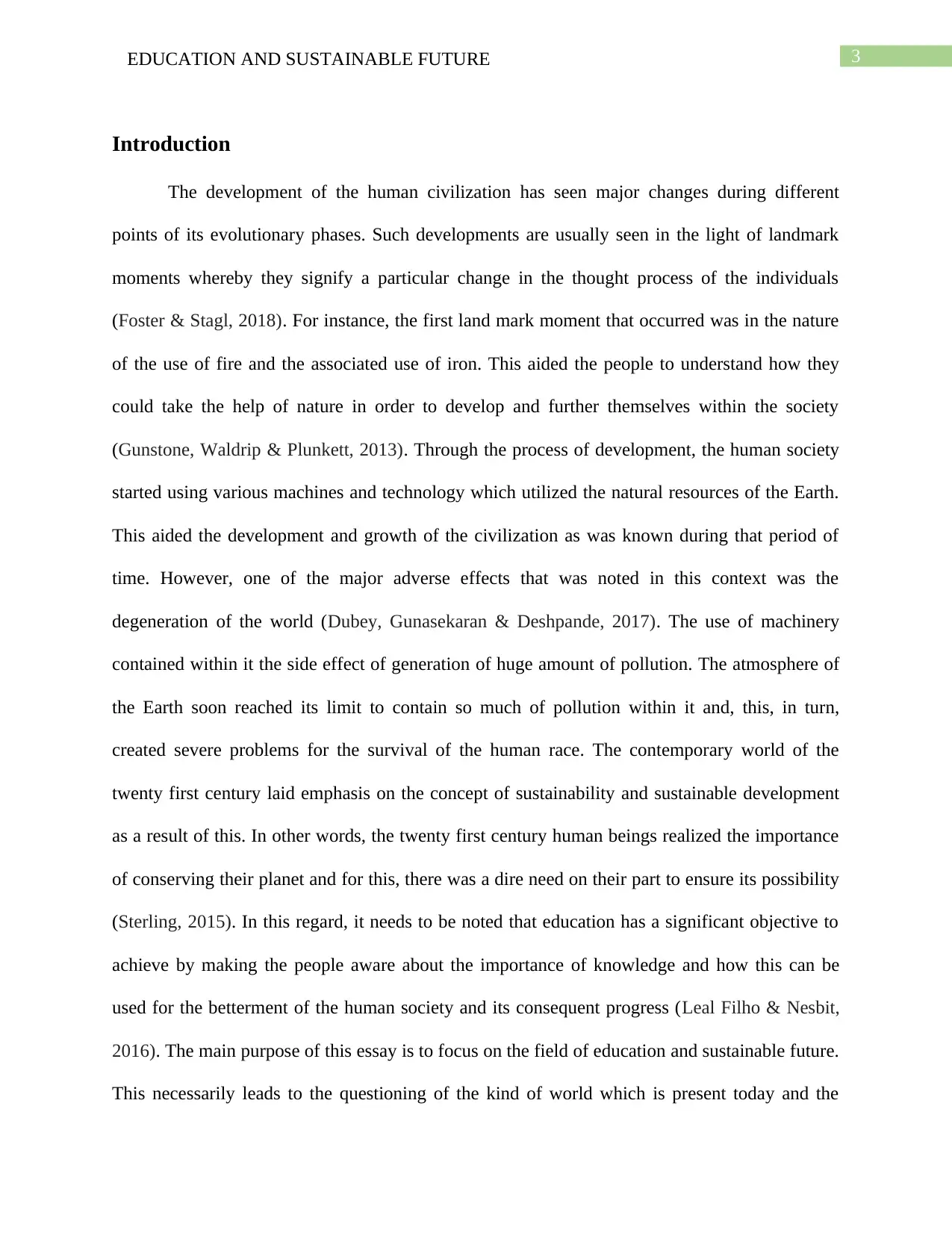
3EDUCATION AND SUSTAINABLE FUTURE
Introduction
The development of the human civilization has seen major changes during different
points of its evolutionary phases. Such developments are usually seen in the light of landmark
moments whereby they signify a particular change in the thought process of the individuals
(Foster & Stagl, 2018). For instance, the first land mark moment that occurred was in the nature
of the use of fire and the associated use of iron. This aided the people to understand how they
could take the help of nature in order to develop and further themselves within the society
(Gunstone, Waldrip & Plunkett, 2013). Through the process of development, the human society
started using various machines and technology which utilized the natural resources of the Earth.
This aided the development and growth of the civilization as was known during that period of
time. However, one of the major adverse effects that was noted in this context was the
degeneration of the world (Dubey, Gunasekaran & Deshpande, 2017). The use of machinery
contained within it the side effect of generation of huge amount of pollution. The atmosphere of
the Earth soon reached its limit to contain so much of pollution within it and, this, in turn,
created severe problems for the survival of the human race. The contemporary world of the
twenty first century laid emphasis on the concept of sustainability and sustainable development
as a result of this. In other words, the twenty first century human beings realized the importance
of conserving their planet and for this, there was a dire need on their part to ensure its possibility
(Sterling, 2015). In this regard, it needs to be noted that education has a significant objective to
achieve by making the people aware about the importance of knowledge and how this can be
used for the betterment of the human society and its consequent progress (Leal Filho & Nesbit,
2016). The main purpose of this essay is to focus on the field of education and sustainable future.
This necessarily leads to the questioning of the kind of world which is present today and the
Introduction
The development of the human civilization has seen major changes during different
points of its evolutionary phases. Such developments are usually seen in the light of landmark
moments whereby they signify a particular change in the thought process of the individuals
(Foster & Stagl, 2018). For instance, the first land mark moment that occurred was in the nature
of the use of fire and the associated use of iron. This aided the people to understand how they
could take the help of nature in order to develop and further themselves within the society
(Gunstone, Waldrip & Plunkett, 2013). Through the process of development, the human society
started using various machines and technology which utilized the natural resources of the Earth.
This aided the development and growth of the civilization as was known during that period of
time. However, one of the major adverse effects that was noted in this context was the
degeneration of the world (Dubey, Gunasekaran & Deshpande, 2017). The use of machinery
contained within it the side effect of generation of huge amount of pollution. The atmosphere of
the Earth soon reached its limit to contain so much of pollution within it and, this, in turn,
created severe problems for the survival of the human race. The contemporary world of the
twenty first century laid emphasis on the concept of sustainability and sustainable development
as a result of this. In other words, the twenty first century human beings realized the importance
of conserving their planet and for this, there was a dire need on their part to ensure its possibility
(Sterling, 2015). In this regard, it needs to be noted that education has a significant objective to
achieve by making the people aware about the importance of knowledge and how this can be
used for the betterment of the human society and its consequent progress (Leal Filho & Nesbit,
2016). The main purpose of this essay is to focus on the field of education and sustainable future.
This necessarily leads to the questioning of the kind of world which is present today and the
Paraphrase This Document
Need a fresh take? Get an instant paraphrase of this document with our AI Paraphraser
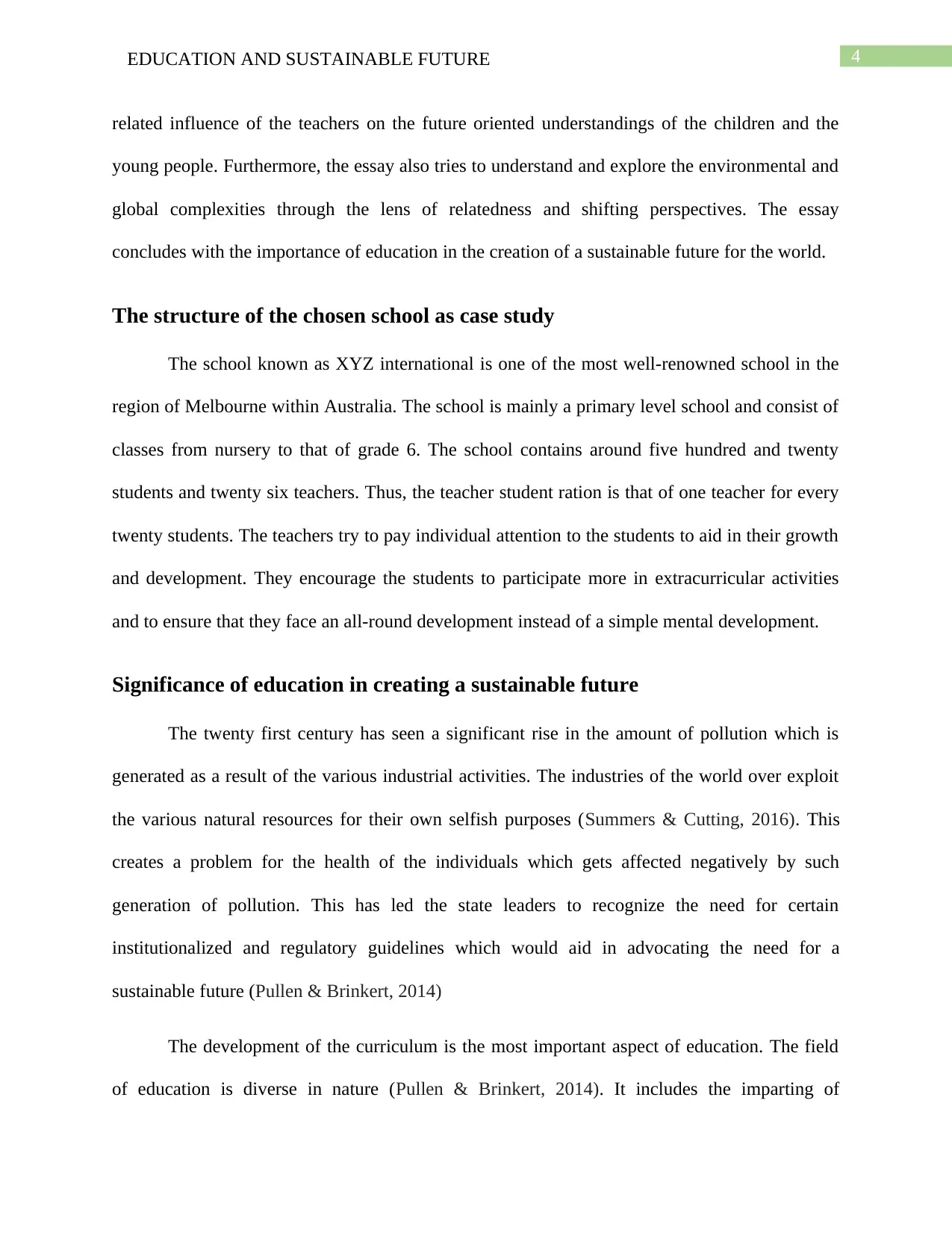
4EDUCATION AND SUSTAINABLE FUTURE
related influence of the teachers on the future oriented understandings of the children and the
young people. Furthermore, the essay also tries to understand and explore the environmental and
global complexities through the lens of relatedness and shifting perspectives. The essay
concludes with the importance of education in the creation of a sustainable future for the world.
The structure of the chosen school as case study
The school known as XYZ international is one of the most well-renowned school in the
region of Melbourne within Australia. The school is mainly a primary level school and consist of
classes from nursery to that of grade 6. The school contains around five hundred and twenty
students and twenty six teachers. Thus, the teacher student ration is that of one teacher for every
twenty students. The teachers try to pay individual attention to the students to aid in their growth
and development. They encourage the students to participate more in extracurricular activities
and to ensure that they face an all-round development instead of a simple mental development.
Significance of education in creating a sustainable future
The twenty first century has seen a significant rise in the amount of pollution which is
generated as a result of the various industrial activities. The industries of the world over exploit
the various natural resources for their own selfish purposes (Summers & Cutting, 2016). This
creates a problem for the health of the individuals which gets affected negatively by such
generation of pollution. This has led the state leaders to recognize the need for certain
institutionalized and regulatory guidelines which would aid in advocating the need for a
sustainable future (Pullen & Brinkert, 2014)
The development of the curriculum is the most important aspect of education. The field
of education is diverse in nature (Pullen & Brinkert, 2014). It includes the imparting of
related influence of the teachers on the future oriented understandings of the children and the
young people. Furthermore, the essay also tries to understand and explore the environmental and
global complexities through the lens of relatedness and shifting perspectives. The essay
concludes with the importance of education in the creation of a sustainable future for the world.
The structure of the chosen school as case study
The school known as XYZ international is one of the most well-renowned school in the
region of Melbourne within Australia. The school is mainly a primary level school and consist of
classes from nursery to that of grade 6. The school contains around five hundred and twenty
students and twenty six teachers. Thus, the teacher student ration is that of one teacher for every
twenty students. The teachers try to pay individual attention to the students to aid in their growth
and development. They encourage the students to participate more in extracurricular activities
and to ensure that they face an all-round development instead of a simple mental development.
Significance of education in creating a sustainable future
The twenty first century has seen a significant rise in the amount of pollution which is
generated as a result of the various industrial activities. The industries of the world over exploit
the various natural resources for their own selfish purposes (Summers & Cutting, 2016). This
creates a problem for the health of the individuals which gets affected negatively by such
generation of pollution. This has led the state leaders to recognize the need for certain
institutionalized and regulatory guidelines which would aid in advocating the need for a
sustainable future (Pullen & Brinkert, 2014)
The development of the curriculum is the most important aspect of education. The field
of education is diverse in nature (Pullen & Brinkert, 2014). It includes the imparting of
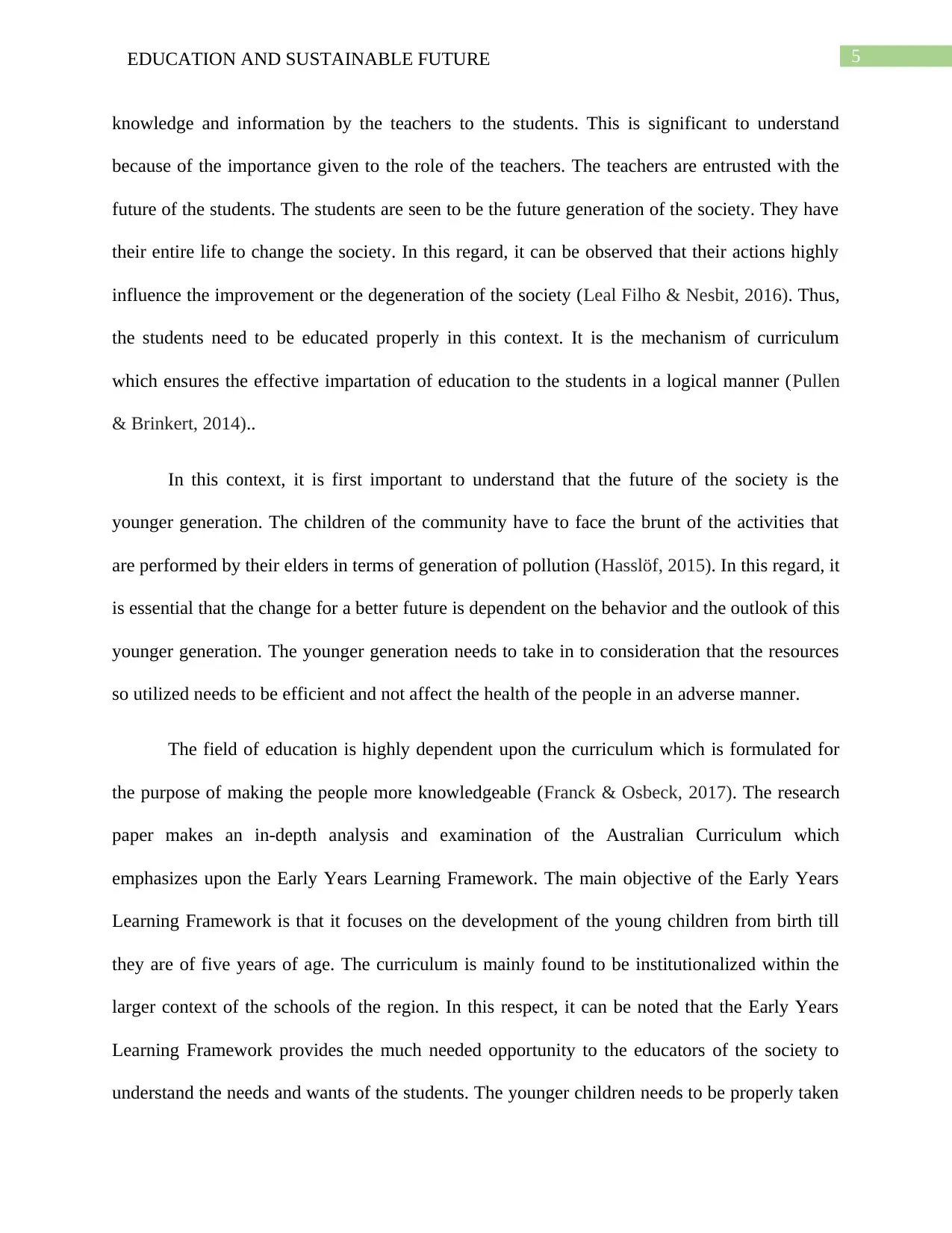
5EDUCATION AND SUSTAINABLE FUTURE
knowledge and information by the teachers to the students. This is significant to understand
because of the importance given to the role of the teachers. The teachers are entrusted with the
future of the students. The students are seen to be the future generation of the society. They have
their entire life to change the society. In this regard, it can be observed that their actions highly
influence the improvement or the degeneration of the society (Leal Filho & Nesbit, 2016). Thus,
the students need to be educated properly in this context. It is the mechanism of curriculum
which ensures the effective impartation of education to the students in a logical manner (Pullen
& Brinkert, 2014)..
In this context, it is first important to understand that the future of the society is the
younger generation. The children of the community have to face the brunt of the activities that
are performed by their elders in terms of generation of pollution (Hasslöf, 2015). In this regard, it
is essential that the change for a better future is dependent on the behavior and the outlook of this
younger generation. The younger generation needs to take in to consideration that the resources
so utilized needs to be efficient and not affect the health of the people in an adverse manner.
The field of education is highly dependent upon the curriculum which is formulated for
the purpose of making the people more knowledgeable (Franck & Osbeck, 2017). The research
paper makes an in-depth analysis and examination of the Australian Curriculum which
emphasizes upon the Early Years Learning Framework. The main objective of the Early Years
Learning Framework is that it focuses on the development of the young children from birth till
they are of five years of age. The curriculum is mainly found to be institutionalized within the
larger context of the schools of the region. In this respect, it can be noted that the Early Years
Learning Framework provides the much needed opportunity to the educators of the society to
understand the needs and wants of the students. The younger children needs to be properly taken
knowledge and information by the teachers to the students. This is significant to understand
because of the importance given to the role of the teachers. The teachers are entrusted with the
future of the students. The students are seen to be the future generation of the society. They have
their entire life to change the society. In this regard, it can be observed that their actions highly
influence the improvement or the degeneration of the society (Leal Filho & Nesbit, 2016). Thus,
the students need to be educated properly in this context. It is the mechanism of curriculum
which ensures the effective impartation of education to the students in a logical manner (Pullen
& Brinkert, 2014)..
In this context, it is first important to understand that the future of the society is the
younger generation. The children of the community have to face the brunt of the activities that
are performed by their elders in terms of generation of pollution (Hasslöf, 2015). In this regard, it
is essential that the change for a better future is dependent on the behavior and the outlook of this
younger generation. The younger generation needs to take in to consideration that the resources
so utilized needs to be efficient and not affect the health of the people in an adverse manner.
The field of education is highly dependent upon the curriculum which is formulated for
the purpose of making the people more knowledgeable (Franck & Osbeck, 2017). The research
paper makes an in-depth analysis and examination of the Australian Curriculum which
emphasizes upon the Early Years Learning Framework. The main objective of the Early Years
Learning Framework is that it focuses on the development of the young children from birth till
they are of five years of age. The curriculum is mainly found to be institutionalized within the
larger context of the schools of the region. In this respect, it can be noted that the Early Years
Learning Framework provides the much needed opportunity to the educators of the society to
understand the needs and wants of the students. The younger children needs to be properly taken
⊘ This is a preview!⊘
Do you want full access?
Subscribe today to unlock all pages.

Trusted by 1+ million students worldwide
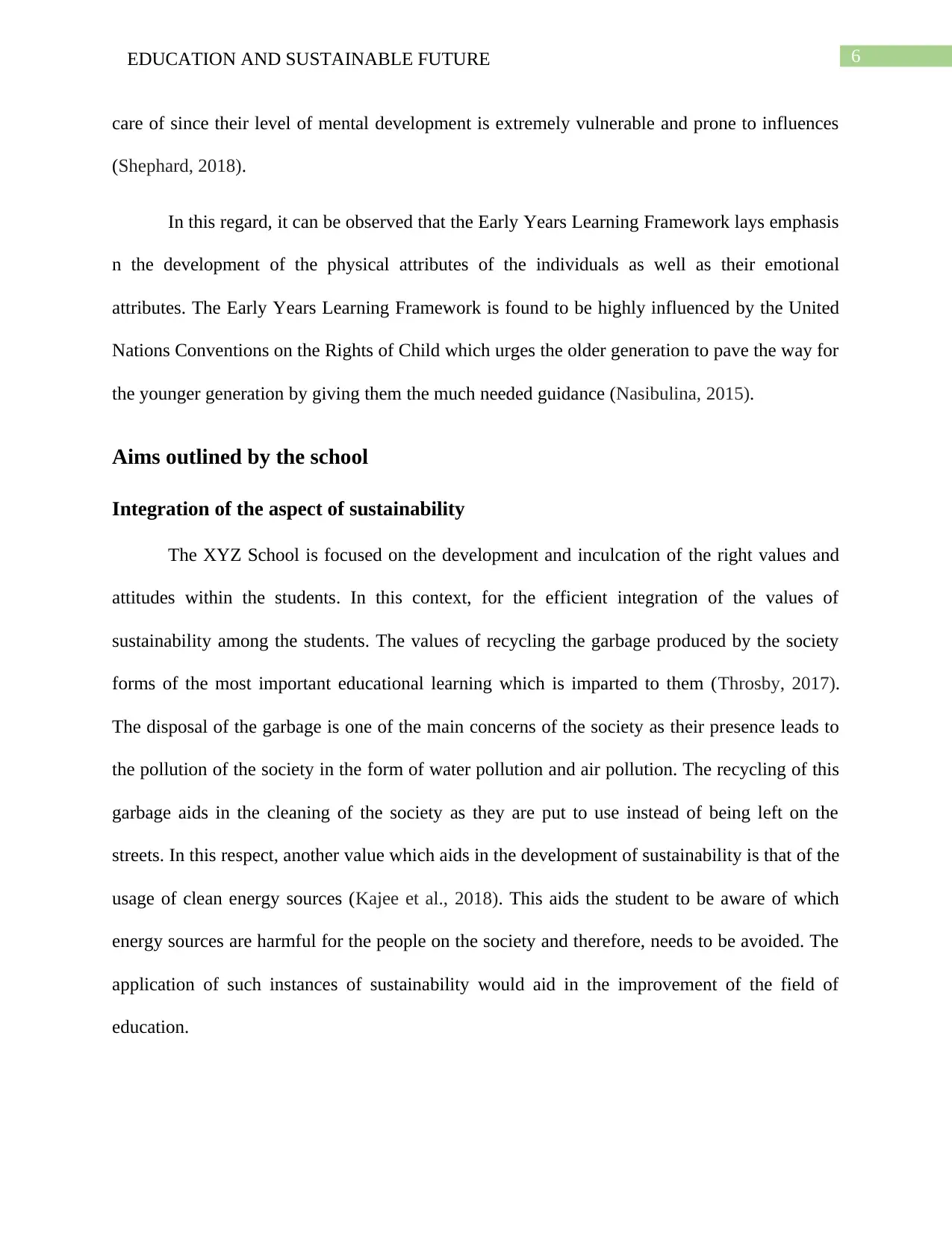
6EDUCATION AND SUSTAINABLE FUTURE
care of since their level of mental development is extremely vulnerable and prone to influences
(Shephard, 2018).
In this regard, it can be observed that the Early Years Learning Framework lays emphasis
n the development of the physical attributes of the individuals as well as their emotional
attributes. The Early Years Learning Framework is found to be highly influenced by the United
Nations Conventions on the Rights of Child which urges the older generation to pave the way for
the younger generation by giving them the much needed guidance (Nasibulina, 2015).
Aims outlined by the school
Integration of the aspect of sustainability
The XYZ School is focused on the development and inculcation of the right values and
attitudes within the students. In this context, for the efficient integration of the values of
sustainability among the students. The values of recycling the garbage produced by the society
forms of the most important educational learning which is imparted to them (Throsby, 2017).
The disposal of the garbage is one of the main concerns of the society as their presence leads to
the pollution of the society in the form of water pollution and air pollution. The recycling of this
garbage aids in the cleaning of the society as they are put to use instead of being left on the
streets. In this respect, another value which aids in the development of sustainability is that of the
usage of clean energy sources (Kajee et al., 2018). This aids the student to be aware of which
energy sources are harmful for the people on the society and therefore, needs to be avoided. The
application of such instances of sustainability would aid in the improvement of the field of
education.
care of since their level of mental development is extremely vulnerable and prone to influences
(Shephard, 2018).
In this regard, it can be observed that the Early Years Learning Framework lays emphasis
n the development of the physical attributes of the individuals as well as their emotional
attributes. The Early Years Learning Framework is found to be highly influenced by the United
Nations Conventions on the Rights of Child which urges the older generation to pave the way for
the younger generation by giving them the much needed guidance (Nasibulina, 2015).
Aims outlined by the school
Integration of the aspect of sustainability
The XYZ School is focused on the development and inculcation of the right values and
attitudes within the students. In this context, for the efficient integration of the values of
sustainability among the students. The values of recycling the garbage produced by the society
forms of the most important educational learning which is imparted to them (Throsby, 2017).
The disposal of the garbage is one of the main concerns of the society as their presence leads to
the pollution of the society in the form of water pollution and air pollution. The recycling of this
garbage aids in the cleaning of the society as they are put to use instead of being left on the
streets. In this respect, another value which aids in the development of sustainability is that of the
usage of clean energy sources (Kajee et al., 2018). This aids the student to be aware of which
energy sources are harmful for the people on the society and therefore, needs to be avoided. The
application of such instances of sustainability would aid in the improvement of the field of
education.
Paraphrase This Document
Need a fresh take? Get an instant paraphrase of this document with our AI Paraphraser
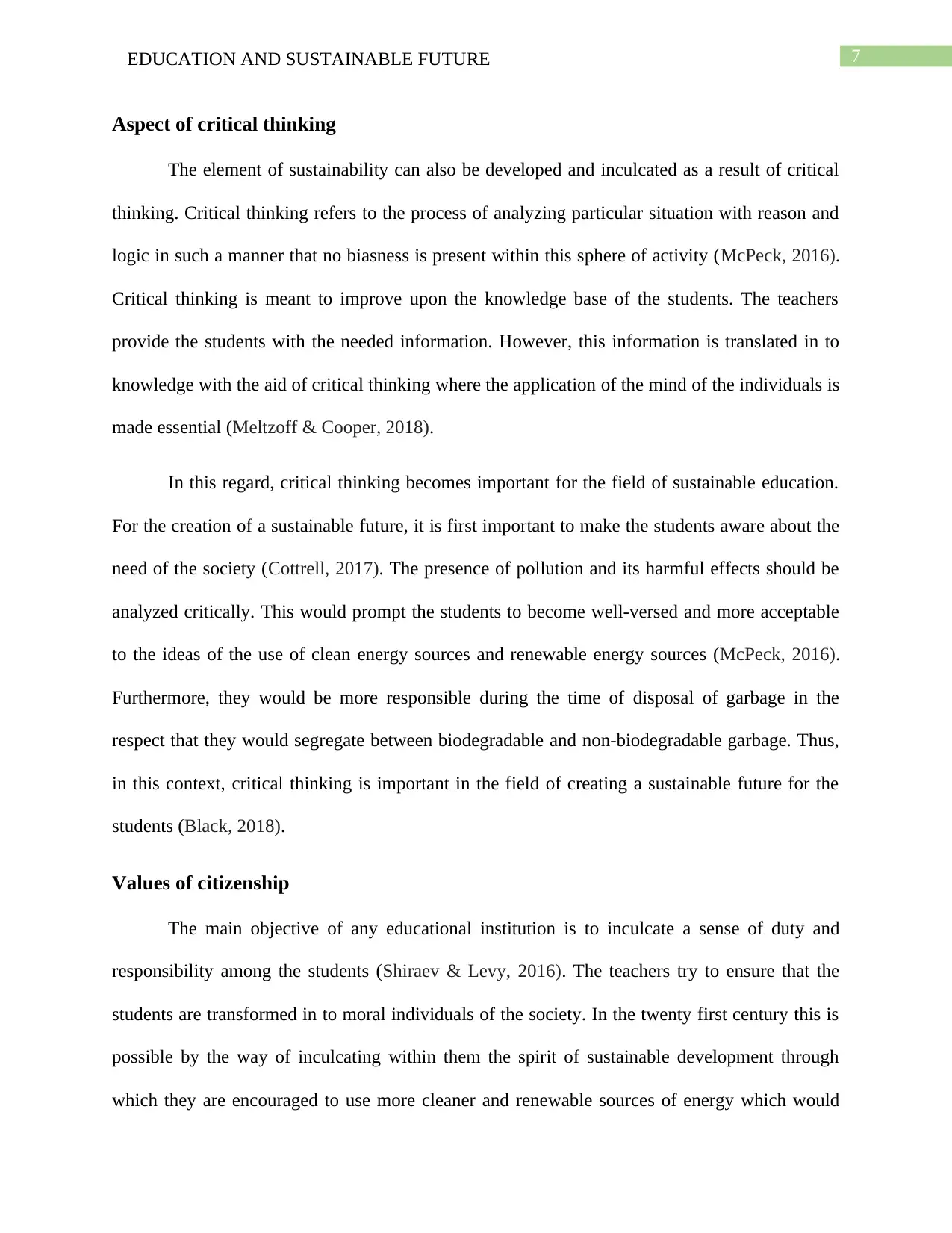
7EDUCATION AND SUSTAINABLE FUTURE
Aspect of critical thinking
The element of sustainability can also be developed and inculcated as a result of critical
thinking. Critical thinking refers to the process of analyzing particular situation with reason and
logic in such a manner that no biasness is present within this sphere of activity (McPeck, 2016).
Critical thinking is meant to improve upon the knowledge base of the students. The teachers
provide the students with the needed information. However, this information is translated in to
knowledge with the aid of critical thinking where the application of the mind of the individuals is
made essential (Meltzoff & Cooper, 2018).
In this regard, critical thinking becomes important for the field of sustainable education.
For the creation of a sustainable future, it is first important to make the students aware about the
need of the society (Cottrell, 2017). The presence of pollution and its harmful effects should be
analyzed critically. This would prompt the students to become well-versed and more acceptable
to the ideas of the use of clean energy sources and renewable energy sources (McPeck, 2016).
Furthermore, they would be more responsible during the time of disposal of garbage in the
respect that they would segregate between biodegradable and non-biodegradable garbage. Thus,
in this context, critical thinking is important in the field of creating a sustainable future for the
students (Black, 2018).
Values of citizenship
The main objective of any educational institution is to inculcate a sense of duty and
responsibility among the students (Shiraev & Levy, 2016). The teachers try to ensure that the
students are transformed in to moral individuals of the society. In the twenty first century this is
possible by the way of inculcating within them the spirit of sustainable development through
which they are encouraged to use more cleaner and renewable sources of energy which would
Aspect of critical thinking
The element of sustainability can also be developed and inculcated as a result of critical
thinking. Critical thinking refers to the process of analyzing particular situation with reason and
logic in such a manner that no biasness is present within this sphere of activity (McPeck, 2016).
Critical thinking is meant to improve upon the knowledge base of the students. The teachers
provide the students with the needed information. However, this information is translated in to
knowledge with the aid of critical thinking where the application of the mind of the individuals is
made essential (Meltzoff & Cooper, 2018).
In this regard, critical thinking becomes important for the field of sustainable education.
For the creation of a sustainable future, it is first important to make the students aware about the
need of the society (Cottrell, 2017). The presence of pollution and its harmful effects should be
analyzed critically. This would prompt the students to become well-versed and more acceptable
to the ideas of the use of clean energy sources and renewable energy sources (McPeck, 2016).
Furthermore, they would be more responsible during the time of disposal of garbage in the
respect that they would segregate between biodegradable and non-biodegradable garbage. Thus,
in this context, critical thinking is important in the field of creating a sustainable future for the
students (Black, 2018).
Values of citizenship
The main objective of any educational institution is to inculcate a sense of duty and
responsibility among the students (Shiraev & Levy, 2016). The teachers try to ensure that the
students are transformed in to moral individuals of the society. In the twenty first century this is
possible by the way of inculcating within them the spirit of sustainable development through
which they are encouraged to use more cleaner and renewable sources of energy which would
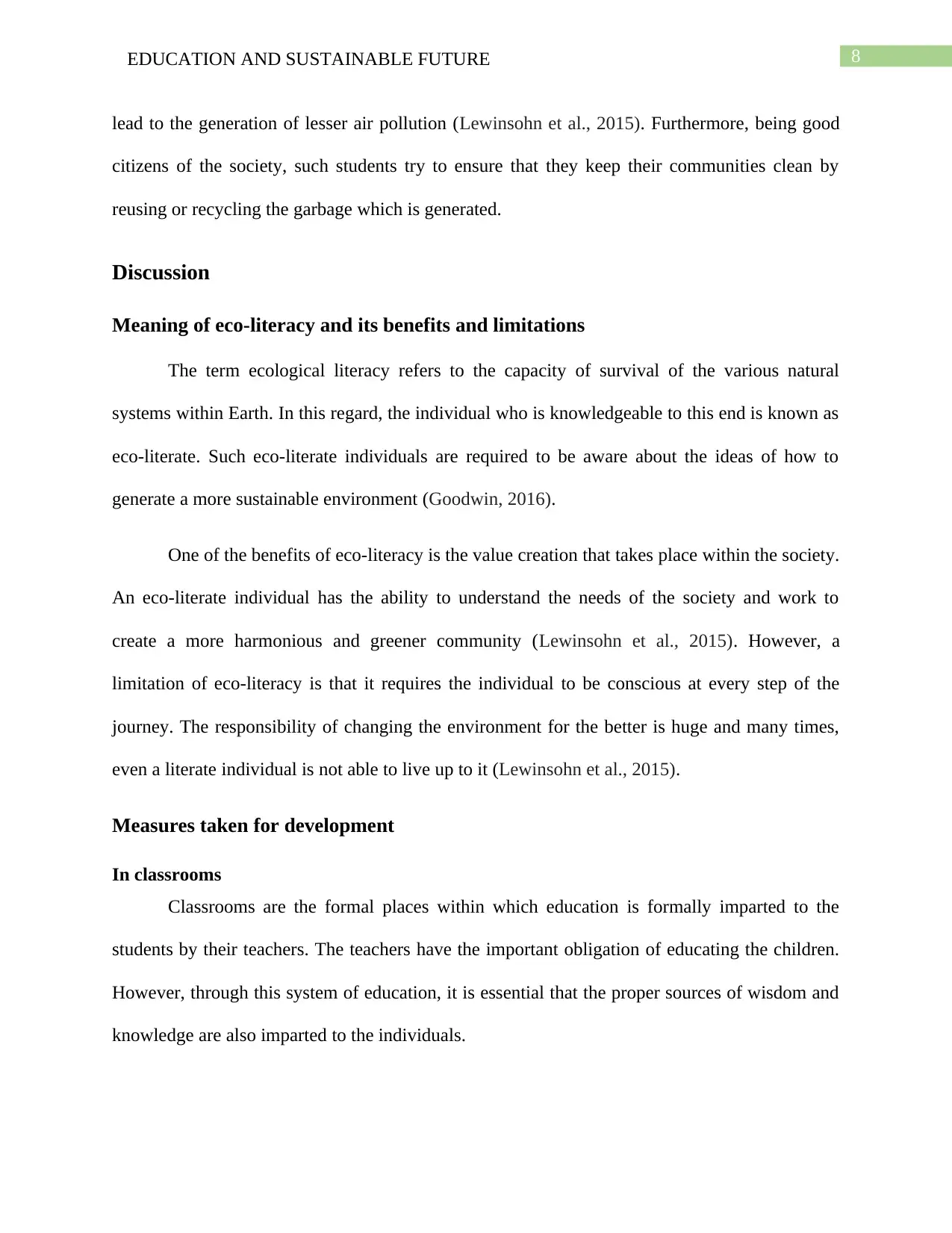
8EDUCATION AND SUSTAINABLE FUTURE
lead to the generation of lesser air pollution (Lewinsohn et al., 2015). Furthermore, being good
citizens of the society, such students try to ensure that they keep their communities clean by
reusing or recycling the garbage which is generated.
Discussion
Meaning of eco-literacy and its benefits and limitations
The term ecological literacy refers to the capacity of survival of the various natural
systems within Earth. In this regard, the individual who is knowledgeable to this end is known as
eco-literate. Such eco-literate individuals are required to be aware about the ideas of how to
generate a more sustainable environment (Goodwin, 2016).
One of the benefits of eco-literacy is the value creation that takes place within the society.
An eco-literate individual has the ability to understand the needs of the society and work to
create a more harmonious and greener community (Lewinsohn et al., 2015). However, a
limitation of eco-literacy is that it requires the individual to be conscious at every step of the
journey. The responsibility of changing the environment for the better is huge and many times,
even a literate individual is not able to live up to it (Lewinsohn et al., 2015).
Measures taken for development
In classrooms
Classrooms are the formal places within which education is formally imparted to the
students by their teachers. The teachers have the important obligation of educating the children.
However, through this system of education, it is essential that the proper sources of wisdom and
knowledge are also imparted to the individuals.
lead to the generation of lesser air pollution (Lewinsohn et al., 2015). Furthermore, being good
citizens of the society, such students try to ensure that they keep their communities clean by
reusing or recycling the garbage which is generated.
Discussion
Meaning of eco-literacy and its benefits and limitations
The term ecological literacy refers to the capacity of survival of the various natural
systems within Earth. In this regard, the individual who is knowledgeable to this end is known as
eco-literate. Such eco-literate individuals are required to be aware about the ideas of how to
generate a more sustainable environment (Goodwin, 2016).
One of the benefits of eco-literacy is the value creation that takes place within the society.
An eco-literate individual has the ability to understand the needs of the society and work to
create a more harmonious and greener community (Lewinsohn et al., 2015). However, a
limitation of eco-literacy is that it requires the individual to be conscious at every step of the
journey. The responsibility of changing the environment for the better is huge and many times,
even a literate individual is not able to live up to it (Lewinsohn et al., 2015).
Measures taken for development
In classrooms
Classrooms are the formal places within which education is formally imparted to the
students by their teachers. The teachers have the important obligation of educating the children.
However, through this system of education, it is essential that the proper sources of wisdom and
knowledge are also imparted to the individuals.
⊘ This is a preview!⊘
Do you want full access?
Subscribe today to unlock all pages.

Trusted by 1+ million students worldwide
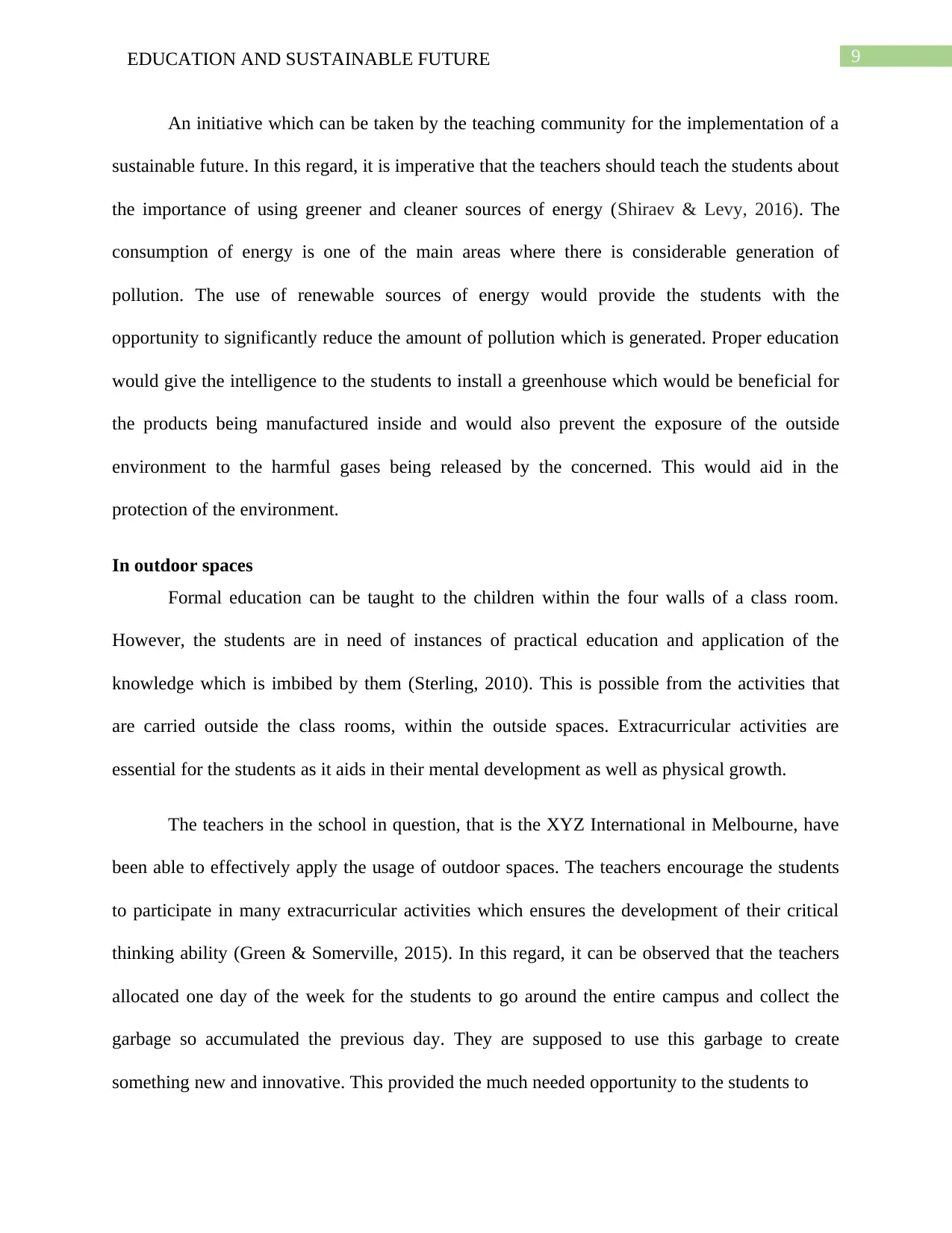
9EDUCATION AND SUSTAINABLE FUTURE
An initiative which can be taken by the teaching community for the implementation of a
sustainable future. In this regard, it is imperative that the teachers should teach the students about
the importance of using greener and cleaner sources of energy (Shiraev & Levy, 2016). The
consumption of energy is one of the main areas where there is considerable generation of
pollution. The use of renewable sources of energy would provide the students with the
opportunity to significantly reduce the amount of pollution which is generated. Proper education
would give the intelligence to the students to install a greenhouse which would be beneficial for
the products being manufactured inside and would also prevent the exposure of the outside
environment to the harmful gases being released by the concerned. This would aid in the
protection of the environment.
In outdoor spaces
Formal education can be taught to the children within the four walls of a class room.
However, the students are in need of instances of practical education and application of the
knowledge which is imbibed by them (Sterling, 2010). This is possible from the activities that
are carried outside the class rooms, within the outside spaces. Extracurricular activities are
essential for the students as it aids in their mental development as well as physical growth.
The teachers in the school in question, that is the XYZ International in Melbourne, have
been able to effectively apply the usage of outdoor spaces. The teachers encourage the students
to participate in many extracurricular activities which ensures the development of their critical
thinking ability (Green & Somerville, 2015). In this regard, it can be observed that the teachers
allocated one day of the week for the students to go around the entire campus and collect the
garbage so accumulated the previous day. They are supposed to use this garbage to create
something new and innovative. This provided the much needed opportunity to the students to
An initiative which can be taken by the teaching community for the implementation of a
sustainable future. In this regard, it is imperative that the teachers should teach the students about
the importance of using greener and cleaner sources of energy (Shiraev & Levy, 2016). The
consumption of energy is one of the main areas where there is considerable generation of
pollution. The use of renewable sources of energy would provide the students with the
opportunity to significantly reduce the amount of pollution which is generated. Proper education
would give the intelligence to the students to install a greenhouse which would be beneficial for
the products being manufactured inside and would also prevent the exposure of the outside
environment to the harmful gases being released by the concerned. This would aid in the
protection of the environment.
In outdoor spaces
Formal education can be taught to the children within the four walls of a class room.
However, the students are in need of instances of practical education and application of the
knowledge which is imbibed by them (Sterling, 2010). This is possible from the activities that
are carried outside the class rooms, within the outside spaces. Extracurricular activities are
essential for the students as it aids in their mental development as well as physical growth.
The teachers in the school in question, that is the XYZ International in Melbourne, have
been able to effectively apply the usage of outdoor spaces. The teachers encourage the students
to participate in many extracurricular activities which ensures the development of their critical
thinking ability (Green & Somerville, 2015). In this regard, it can be observed that the teachers
allocated one day of the week for the students to go around the entire campus and collect the
garbage so accumulated the previous day. They are supposed to use this garbage to create
something new and innovative. This provided the much needed opportunity to the students to
Paraphrase This Document
Need a fresh take? Get an instant paraphrase of this document with our AI Paraphraser
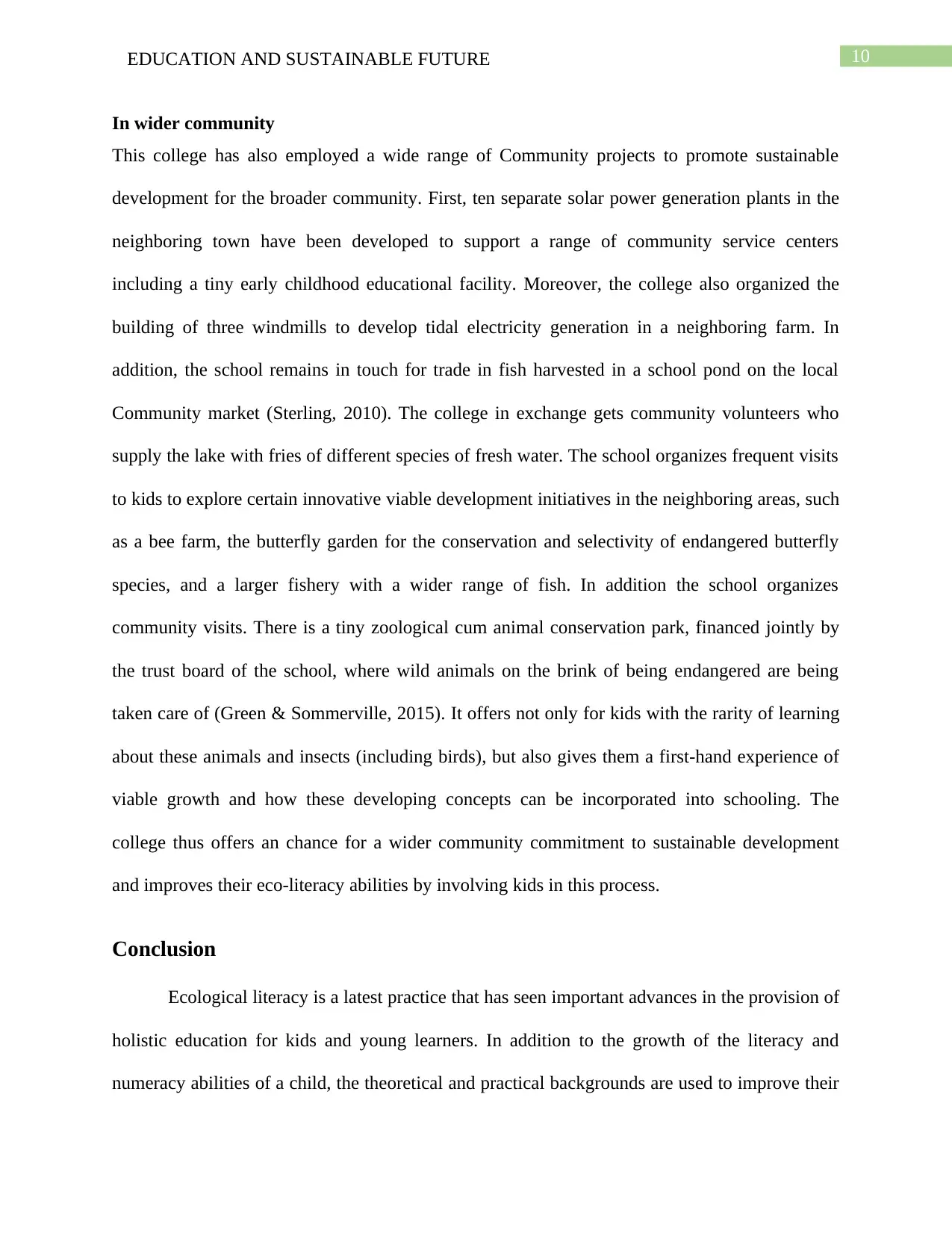
10EDUCATION AND SUSTAINABLE FUTURE
In wider community
This college has also employed a wide range of Community projects to promote sustainable
development for the broader community. First, ten separate solar power generation plants in the
neighboring town have been developed to support a range of community service centers
including a tiny early childhood educational facility. Moreover, the college also organized the
building of three windmills to develop tidal electricity generation in a neighboring farm. In
addition, the school remains in touch for trade in fish harvested in a school pond on the local
Community market (Sterling, 2010). The college in exchange gets community volunteers who
supply the lake with fries of different species of fresh water. The school organizes frequent visits
to kids to explore certain innovative viable development initiatives in the neighboring areas, such
as a bee farm, the butterfly garden for the conservation and selectivity of endangered butterfly
species, and a larger fishery with a wider range of fish. In addition the school organizes
community visits. There is a tiny zoological cum animal conservation park, financed jointly by
the trust board of the school, where wild animals on the brink of being endangered are being
taken care of (Green & Sommerville, 2015). It offers not only for kids with the rarity of learning
about these animals and insects (including birds), but also gives them a first-hand experience of
viable growth and how these developing concepts can be incorporated into schooling. The
college thus offers an chance for a wider community commitment to sustainable development
and improves their eco-literacy abilities by involving kids in this process.
Conclusion
Ecological literacy is a latest practice that has seen important advances in the provision of
holistic education for kids and young learners. In addition to the growth of the literacy and
numeracy abilities of a child, the theoretical and practical backgrounds are used to improve their
In wider community
This college has also employed a wide range of Community projects to promote sustainable
development for the broader community. First, ten separate solar power generation plants in the
neighboring town have been developed to support a range of community service centers
including a tiny early childhood educational facility. Moreover, the college also organized the
building of three windmills to develop tidal electricity generation in a neighboring farm. In
addition, the school remains in touch for trade in fish harvested in a school pond on the local
Community market (Sterling, 2010). The college in exchange gets community volunteers who
supply the lake with fries of different species of fresh water. The school organizes frequent visits
to kids to explore certain innovative viable development initiatives in the neighboring areas, such
as a bee farm, the butterfly garden for the conservation and selectivity of endangered butterfly
species, and a larger fishery with a wider range of fish. In addition the school organizes
community visits. There is a tiny zoological cum animal conservation park, financed jointly by
the trust board of the school, where wild animals on the brink of being endangered are being
taken care of (Green & Sommerville, 2015). It offers not only for kids with the rarity of learning
about these animals and insects (including birds), but also gives them a first-hand experience of
viable growth and how these developing concepts can be incorporated into schooling. The
college thus offers an chance for a wider community commitment to sustainable development
and improves their eco-literacy abilities by involving kids in this process.
Conclusion
Ecological literacy is a latest practice that has seen important advances in the provision of
holistic education for kids and young learners. In addition to the growth of the literacy and
numeracy abilities of a child, the theoretical and practical backgrounds are used to improve their
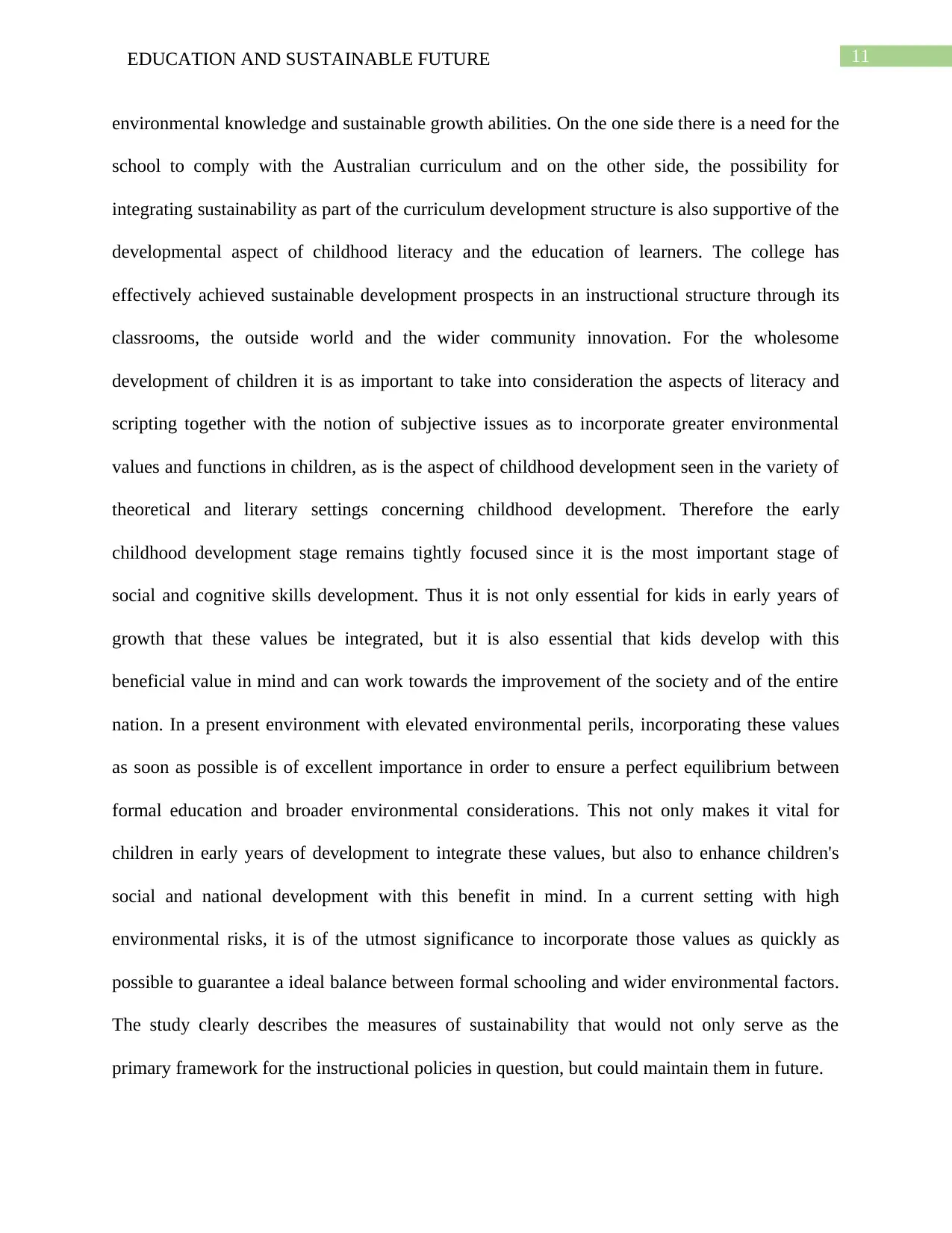
11EDUCATION AND SUSTAINABLE FUTURE
environmental knowledge and sustainable growth abilities. On the one side there is a need for the
school to comply with the Australian curriculum and on the other side, the possibility for
integrating sustainability as part of the curriculum development structure is also supportive of the
developmental aspect of childhood literacy and the education of learners. The college has
effectively achieved sustainable development prospects in an instructional structure through its
classrooms, the outside world and the wider community innovation. For the wholesome
development of children it is as important to take into consideration the aspects of literacy and
scripting together with the notion of subjective issues as to incorporate greater environmental
values and functions in children, as is the aspect of childhood development seen in the variety of
theoretical and literary settings concerning childhood development. Therefore the early
childhood development stage remains tightly focused since it is the most important stage of
social and cognitive skills development. Thus it is not only essential for kids in early years of
growth that these values be integrated, but it is also essential that kids develop with this
beneficial value in mind and can work towards the improvement of the society and of the entire
nation. In a present environment with elevated environmental perils, incorporating these values
as soon as possible is of excellent importance in order to ensure a perfect equilibrium between
formal education and broader environmental considerations. This not only makes it vital for
children in early years of development to integrate these values, but also to enhance children's
social and national development with this benefit in mind. In a current setting with high
environmental risks, it is of the utmost significance to incorporate those values as quickly as
possible to guarantee a ideal balance between formal schooling and wider environmental factors.
The study clearly describes the measures of sustainability that would not only serve as the
primary framework for the instructional policies in question, but could maintain them in future.
environmental knowledge and sustainable growth abilities. On the one side there is a need for the
school to comply with the Australian curriculum and on the other side, the possibility for
integrating sustainability as part of the curriculum development structure is also supportive of the
developmental aspect of childhood literacy and the education of learners. The college has
effectively achieved sustainable development prospects in an instructional structure through its
classrooms, the outside world and the wider community innovation. For the wholesome
development of children it is as important to take into consideration the aspects of literacy and
scripting together with the notion of subjective issues as to incorporate greater environmental
values and functions in children, as is the aspect of childhood development seen in the variety of
theoretical and literary settings concerning childhood development. Therefore the early
childhood development stage remains tightly focused since it is the most important stage of
social and cognitive skills development. Thus it is not only essential for kids in early years of
growth that these values be integrated, but it is also essential that kids develop with this
beneficial value in mind and can work towards the improvement of the society and of the entire
nation. In a present environment with elevated environmental perils, incorporating these values
as soon as possible is of excellent importance in order to ensure a perfect equilibrium between
formal education and broader environmental considerations. This not only makes it vital for
children in early years of development to integrate these values, but also to enhance children's
social and national development with this benefit in mind. In a current setting with high
environmental risks, it is of the utmost significance to incorporate those values as quickly as
possible to guarantee a ideal balance between formal schooling and wider environmental factors.
The study clearly describes the measures of sustainability that would not only serve as the
primary framework for the instructional policies in question, but could maintain them in future.
⊘ This is a preview!⊘
Do you want full access?
Subscribe today to unlock all pages.

Trusted by 1+ million students worldwide
1 out of 16
Related Documents
Your All-in-One AI-Powered Toolkit for Academic Success.
+13062052269
info@desklib.com
Available 24*7 on WhatsApp / Email
![[object Object]](/_next/static/media/star-bottom.7253800d.svg)
Unlock your academic potential
Copyright © 2020–2025 A2Z Services. All Rights Reserved. Developed and managed by ZUCOL.





